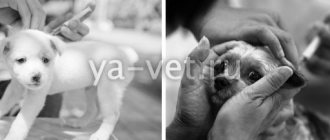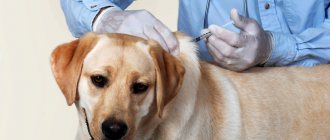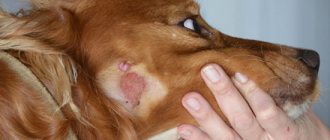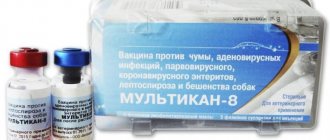Toy Terrier. What vaccinations are needed?
Veterinarians divide vaccinations into mandatory and optional.
Mandatory vaccinations for a toy terrier.
Mandatory - vaccines against dangerous diseases that lead to death.
- rabies. This disease is dangerous for both dogs and humans. The main danger is that at the moment, once clinical symptoms appear, there are no effective treatments. So after this, think about whether that terrier needs to be vaccinated against rabies or not.
- bordetellosis. The infection, entering the dog’s body, causes inflammation of the respiratory system (lungs, trachea and bronchi).
- plague. One of the most common and highly contagious diseases. The highest percentage of deaths among young dogs is caused by plague.
- viral hepatitis. The risk group includes young animals. Therapy is carried out through the administration of allergenic serum.
- adenovirus infection. An infection not detected in a timely manner or an advanced stage leads to the development of acute forms of the disease.
- parvovirus enteritis . The causative agent of parvovirus is characterized by high resistance to any influence, even physical and chemical. The virus is dangerous because it can remain active in the environment for several months.
- leptospirosis (infectious jaundice). Leptospira microbes affect the circulatory system and internal organs of the dog. It is also dangerous for humans.
Additional vaccinations (optional vaccinations).
Not all toy terriers need additional vaccinations. The veterinarian will develop an individual vaccination plan for your dog, depending on the developed immunity and the general condition of the animal’s body.
Optional vaccines include vaccinations against the following diseases:
- piroplasmor. This disease is caused by the bite of a forest tick. This disease is common in European countries.
- tick-borne borreliosis (Lyme disease), the causative agent of which is also a tick.
- fungal diseases.
- canine parainfluenza is dangerous for toy terrier puppies because it is transmitted by airborne droplets.
- coronavirus enteritis. A pet can catch the disease by sniffing the feces of an infected pet or through direct contact with a sick dog.
The cost of health, if we consider vaccinations for a toy terrier, is influenced by such factors as the vaccine manufacturer and the place of vaccination of the toy terrier. The price of vaccination ranges from 150 to 400 hryvnia. If the price is higher, then the price may also include entering information about the vaccine into the veterinary passport of the toy terrier.
Vaccination schedule from birth
Your dog should be vaccinated according to schedule. To do this, you need to know the order and timing that must be maintained between vaccinations.
The first vaccination is done 1.5-2 months after the puppy is born. You may ask why not right away? But because from birth the baby receives immunity from the mother. After a month and a half, the immunity weakens and the puppies begin to get sick. This is where you need to start getting vaccinations to avoid infecting your pet with various infections.
I'll repeat it again. If you want to take your pet abroad, then you need to administer only imported vaccines, for example, Nobivak, Hexadog, Eurikan, etc.
Let's look at vaccination schemes with these drugs. My Jackusik and I have traveled abroad several times, so we vaccinate him with Nobivak. Let's start with him.
Nobivak
The first vaccination can be carried out with the Nobivak Puppy DP vaccine at the age of 4 weeks, followed by the use of the Nobivak DHPPi vaccine according to the following scheme:
- 2 months (8 weeks) – second vaccination – Nobivak DHP + Nobivak L.
- 3 months (12 weeks) – third vaccination – Nobivak DHPPi + Nobivak LR.
After the third vaccination, there is a 14-day quarantine, and then you can go outside for a walk!
Further like this:
- After 1 year - the fourth vaccination - Nobivak DHPPi + Nobivak LR.
- Next: 1 time annually and for life – Nobivak DHPPi + Nobivak LR.
Here is our Dzhekushka's passport. These are necessary vaccinations that are given once a year.
Nobivac Rabies with a mark in the veterinary passport.
Nobivak DHPPi + Nobivak Lepto with a mark in the veterinary passport.
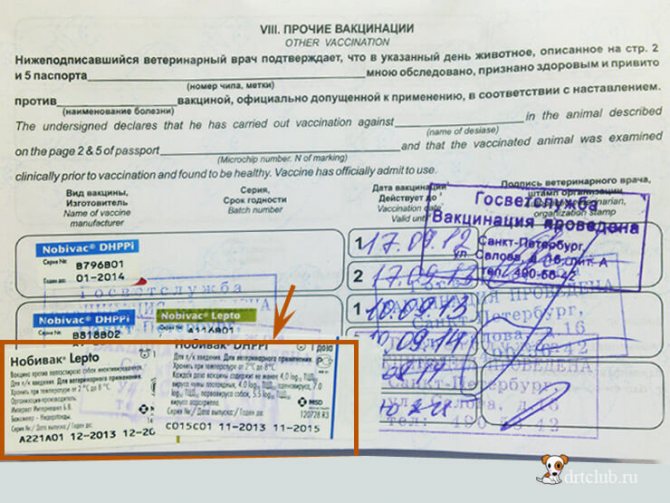
Eurikan
We go according to this scheme:
- 2 months (8 weeks) – first vaccination – Eurican DHPPI2 + Eurican L.
- 3 months (12 weeks) – second vaccination – Eurican DHPPI2 + Eurican LR.
- After 1 year - the third vaccination - Eurican DHPPI2 + Eurican L.
- Next: 1 time annually and for life – Eurican DHPPI2 + Eurican L.
Hexadog
In the following way:
- 2 months (8 weeks) – first vaccination – Eurican DHPPI2 + Eurican L.
- 3 months (12 weeks) – second vaccination – Hexadog.
- After 1 year - the third vaccination - Hexadog.
- Next: 1 time annually and throughout your life - Hexadog.
Immunity after vaccination develops no earlier than 10 days later. Therefore, after each vaccination, it is imperative to quarantine for 14 days.
And do not forget that the veterinarian must mark any vaccination in the veterinary passport. If he didn't do this, then be sure to tell him about it.
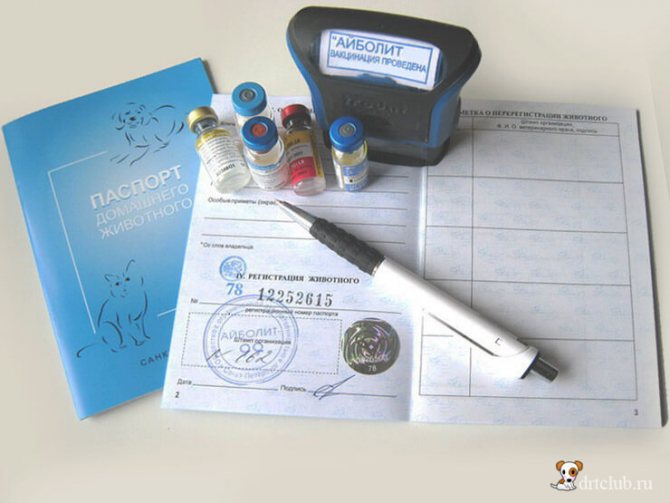
When should a toy terrier get his first vaccination?
Caring for the health of a decorative dog puppy begins literally from the first minutes of its birth. Vaccination of Toy Terrier puppies begins at the age of 3-5 weeks, depending on the vital signs of the body and the type of vaccination.
The fact is that currently there is an excellent selection of vaccines for dogs, which consists of mono-vaccines aimed at developing immunity against one disease, and complex vaccines consisting of antigens of several diseases.
The greatest convenience is manifested in the use of complex vaccinations for toy terrier puppies. The most common infectious antigens are included in one preparation. Complex vaccination causes the body to develop immunity against rabies, parvovirus enteritis, canine distemper, rhinotracheitis, leptospirosis and adenoviral hepatitis.
Your right to choose a live or killed vaccine. If the first consists of pathogens that were grown in laboratory conditions, then the second is filled with completely neutralized dead microorganisms. It is worth drawing your attention to the following difference between these types of vaccines. Strains of live antigens introduced to the terrier provoke diseases in the dog, but in a very mild form, and dead pathogens do not entail any deviations in the post-vaccination period. But it is live strains that provide more lasting immunity.
The quantitative content of pathogens in a complex vaccination also plays a role. The higher the number of antigens in the vaccine, the stronger the manifestation of disease symptoms in the animal, but at the same time, the higher the formation of high immunity in the dog.
The first vaccination for a toy terrier puppy does not protect against diseases, since it is given against infectious diseases called “kennel cough” - bordetellosis and canine parainfluenza. The drug is administered when the puppy is 4-6 weeks old.
This is followed by quarantine for two weeks, after which the decorative dog is given a second vaccination. Please note that you should buy a puppy only after the second vaccination and subsequent quarantine. If a breeder offers you a dog with one vaccination, then no matter how much you would like to quickly cuddle a little bundle of happiness, give up this idea - wait. After all, in the event of any disease, you may not be able to cope with the disease or not respond to the symptoms that appear in a timely manner. Remember - the first two vaccinations are done by the breeder.
What is dog vaccination
Vaccination is a preventive procedure aimed at reducing the risk of contracting infectious diseases. The vaccine itself is the causative agent of the disease in a weakened form. The dog's body is forcibly infected with a small amount of infection, thanks to which it begins to fight it. And, in the end, immunity is developed.
As a rule, dogs are vaccinated against infections such as canine distemper, hepatitis, adenovirus, parvovirus and coronavirus infections, leptospirosis, rabies. All these diseases are very difficult for animals to tolerate, so it is easier to prevent them than to treat them.
Carrying out this procedure does not exclude the possibility of contracting any of the above infections, but it guarantees that the disease will be mild and without complications.
When should a toy terrier be vaccinated?
In order not to doubt or worry about when to vaccinate your toy terrier, we offer you a classic schedule of vaccinations for your toy terrier.
| Dog age | Vaccination | |||
| Complex vaccine (canine distemper, adenoviral hepatitis, respiratory adenovirus, parvovirus enteritis, parainfluenza) | Leptospirosis | “Kennel cough” (parainfluenza, bordetellosis) | Rabies | |
| 4-6 weeks | + | + | ||
| 8-9 weeks | + | + | ||
| 12 weeks | + | + | + | |
| 1 year | + | + | + | + |
| 2 years | + | + | ||
| 3 years | + | + | ||
| 4 years | + | + | + | + |
| 5 years | + | + | ||
| 6 years | + | + | ||
| 7 years | + | + | + | + |
| 8 years | + | + | ||
| 9 years | + | + | ||
| 10 years | + | + | + | + |
| 11 years | + | + | ||
| 12 years | + | + |
There are several rules associated with vaccinations for miniature terriers, including Russian toy terriers, which you, as the owner, must follow:
- Before introducing the antigen into the dog’s body, prepare the animal. Cleanse your pet's body of helminths that reduce the protective function of the toy terrier's body. Get rid of fleas and ticks, if present. A couple of days before the vaccination procedure itself, monitor the toy’s body temperature. The norm is a temperature from 37.5 to 39 degrees.
- If the dog is unwell, notify the veterinarian so that he can reschedule the procedure.
- Observe your pet for the first two hours after vaccination to ensure that he does not have an allergic reaction to the drug.
- During the quarantine period (two weeks after vaccination), reduce or completely eliminate contact with other dogs. Follow all the rules for caring for your pet, especially regarding hygiene. Do not allow the animal to overheat or hypothermia, do not bathe it, do not change its diet, or give it great physical activity.
- any changes in behavior during this period should be the reason for an early visit to the veterinarian.
After fourteen days, the terrier’s immunity will be formed and you can rest assured about your friend.
Can a vaccine be harmful?
With the help of a vaccine, a virus is introduced into the animal’s body, which has been weakened or killed by special manipulations. To develop immunity, the puppy must have a lot of strength and no health problems. Otherwise, it will be difficult for the defense mechanism to overcome hostile bodies, and the baby may become infected with the drug for which he was injected.

To prevent such cases, it is prohibited to vaccinate:
- weakened and sick dogs;
- puppies that have been in contact with presumably sick animals;
- medications that have expired or whose storage and transportation conditions have been violated: under direct sunlight, in conditions of high temperature or humidity;
- if there is a possibility that the kitten is infected;
- if less than 2 weeks have passed since antibiotic therapy;
- before and after any surgical interventions.
If you suspect that your pet has any disease, including the one against which vaccination is being carried out, it is necessary to submit urine and blood for testing. Their result will make it possible to verify the absence or presence of the virus in the baby, even if there are no characteristic manifestations of infection.

